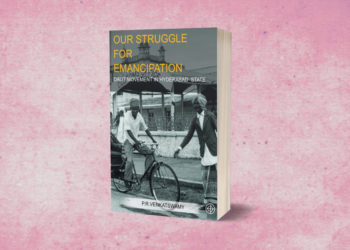Written by Aijaz Ashraf Wani, What happened to Governance in Kashmir, examines the policies, strategies, and tactics to manage the conflicted state of Jammu and Kashmir during 1948-90. The writer argues in his book that as the general attitude of the government has been status quoist, the clash between the state and the society was inevitable. It shows how the policies deployed to “create order in disorder” functioned inversely and turned Kashmir into a smoldering volcano which erupted in 1989-90.
Based on a variety of comtemporary sources, the book deals with many aspects of Kashmir’s governance through different political phases.
The following is an excerpt from the chapter “How New Was the New Kashmir (1948-53)” of the book.
 Image courtesy: Amazon
Image courtesy: Amazon
The year 1953 began with a renewed resolve by both Jammu and Ladakh to exasperate Abdullah completely and bring about his downfall. The Praja Parishad resorted to demonstrations, violence, sabotage, and disruption of work in various towns of Jammu by recruiting the support of Jan Sangh volunteers from Punjab.223 It raised emotionally charged slogans rejecting the special position of Kashmir.224 Nehru termed the movement ‘most pernicious and malignant’ in its ‘narrow, bigoted, reactionary and revivalist approach’.225 The Times (London) reported that the movement engineered and spearheaded by Praja Parishad ‘has gone deep into the rural areas where the masses take part in Parishad processions and demonstrations and stubbornly endure police baton charges and tear gas attacks’.226 ‘Even in the seventh week of its agitation, planned protest meetings and processions, in defiance of the government ban, were a common sight.’227
In this situation of total breakdown of law and order (in spite of police detachments having been called from Punjab to assist the local police), the head lama of Ladakh raised the ante and vociferously demanded separation from Kashmir. In fact, it was from December 1952 that we find him raising his pitch. He maintained that Ladakh had no bond with Kashmir. There was only one bond that linked Ladakh with Kashmir, and that bond was the maha- raja. With the abolition of the hereditary monarchy, the bond was automatically broken.228 He categorically mentioned that in no way—racially, linguistically, or culturally—did Ladakh have affinity with Kashmir. Interestingly, though, in respect of these cultural attributes, Ladakh is also equally distinct from Jammu, but the lama preferred to be a part of Jammu.229
In his usual way, Sheikh Abdullah blew both hot and cold. However, he was so pressurized by the whirlwind of unending agitations that he offered both Jammu and Ladakh autonomous positions within the proposed ‘Autonomous Federated Units of the Republic of India’—the plan prepared as a solution to the centrifugal demand of the Praja Parishad and the head lama. But this reform too could not satisfy them, for by now they had succeeded in grad- uating their movement to a pan-Indian movement. The three communalist parties—Hindu Mahasabha, Jan Sangh, and Ram Rajya Parishad—threw their lot in with the Praja Parishad agitation and started a nationwide satyagraha for the complete integration of Kashmir with India. Signiftcantly, according to Joseph Korbel, even Jawaharlal Nehru ‘could not ignore their voice altogether, more so . . . the National Congress has not remained entirely deaf to their cries’.230 The death of Shyama Prasad Mukherjee from a heart attack in custody in Srinagar added fuel to the fire. Nehru who had initially looked askance at the agitators now changed his tone and expressed his sympathies with them. Immediately after these expressions by Nehru, the agitation was called off on 7 July 1953, but ‘not before it had caused irreparable damage to the state’s organic unity’.231
223 Mullik, My Years with Nehru-Kashmir, 34.
224 The slogan Ek Pradhan, Ek Nishan, Ek Vidhan (One President, One Flag, One Constitution) became the battle cry of the Parishad, demanding abrogation of the special status of J&K.
225 Hindu, 26 April 1953.
226 Times (London), 24 January 1953.
227 Saraf, Kashmiris Fight for Freedom, vol. II, 1207.
228 Kashmir Affairs, Rawalpindi, no. 49, 6 December 1952, quoted in Korbel, Danger in Kashmir, 233.
229 Times of India (Bombay), 30 April 1953.
230 Korbel, Danger in Kashmir, 234
231 Das, Jammu and Kashmir, 203.
Read more:
“Are we going to forget people while defining the nation?”
“Unresolved Conflict in Kashmir is a Threat to Indian Democracy”




